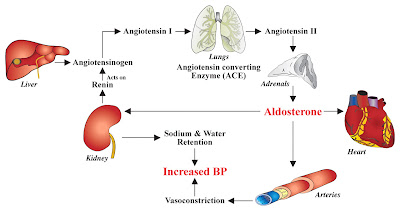
One of the coolest aspects of the renin-angiotensin-aldosterone system (RAAS) is that it involves multiple organ systems: the liver, lung, adrenal gland, kidney, and vasculature are all prominently involved. It never hurts to review basic physiologic principles, right? Listed are the three main components of the RAAS and their main mechanisms of action.
1. Renin is a peptide hormone secreted from the juxtaglomerular cells of the afferent arteriole in response to 3 main stimuli: (a) renal hypoperfusion, (b) decreased distal chloride delivery to the macula densa, and (c) increased sympathetic activity. Renin antagonists such as aliskiren are presently being tested as antihypertensive agenst with thus far promising results.
2. Angiotensinogen--which is synthesized and secreted from the liver--is cleaved by renin in the systemic circulation to form angiotensin I.
Angiotensin I is cleaved to form angiotensin II by angiotensin converting enzyme (ACE), which is found predominantly within lung endothelium. ACE-inhibitors, as their name implies, targets the ACE enzyme and is one of the most potent anti-hypertensives (and GFR-preserving) therapies available.
Angiotensin II has the following physiologic effects, which it carries out via binding to AT1 and AT2 receptors. Drugs which block the ability of angiotensin II to bind to its receptors ("angiotensin receptors blockers", or ARBs) make up another highly successful and renoprotective antihypertensive therapy. Angiotensin II binding to its receptors have the following major effects:
a) angiotensin II acts as a systemic vasoconstrictor.
b) angiotensin II causes renal efferent arterial vasoconstriction. Acutely, efferent vasoconstriction should increase GFR; however, over time the increased glomerular pressure leads to glomerular damage and, ultimately, renal injury.
c) angiotensin II increases secretion of aldosterone from the zona glomerulosa of adrenal cortex.
3. Aldosterone: in cortical collecting duct cells, aldosterone diffuses into the cell and interacts with the mineralocorticoid receptor, which upon binding translocates to the nucleus and increases expression of ENac. The end result of aldosterone action is sodium reabsorption and potassium & hydrogen secretion. In addition to angiotensin II, hyperkalemia can also stimulate aldosterone secretion. The drug spironolactone interferes with aldosterone interacting with its receptors, and can be effective in the treatment of hypertension.















1 comment:
I have being researching about aldosterone and reading your blog, I found your post very helpful.
Post a Comment